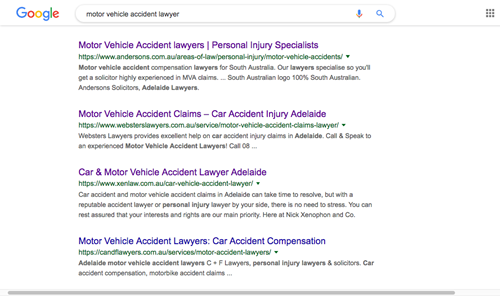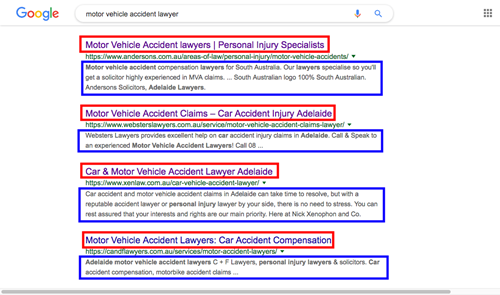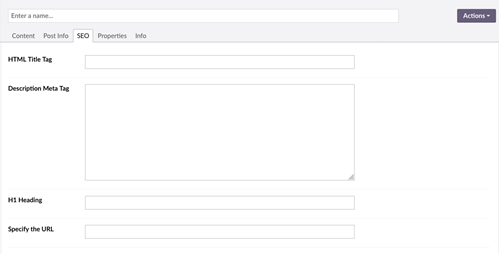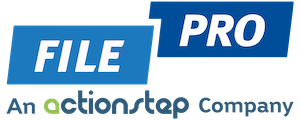This article first appeared on the Social Hive website in March 2019. The original article can be viewed here.
To rank well in organic search and improve your law firm’s search engine marketing (SEM) results, it pays to give some attention to meta tags. There are many types of meta tags which web developers can use to enhance your web page’s performance.
Today, the focus is on the title tag – one of the most valuable meta tags for SEO. The title tag, when optimised, can have a direct impact on how your page ranks and converts.
Though it may sound technical, like a lot of SEO, it’s actually quite simple and easy to implement with just a little effort.
So let’s look a little closer at meta tags and title tags – and why they matter.
Meta tags explained
Meta tags are snippets of text that describe a web page’s content. They help tell search engines what the page is about. The “meta” stands for “metadata”, which means data about the content on your page.
As a visitor to a web page, you won’t see the meta tags. They’re hidden in the page’s source code.
Here’s an example of what a meta description tag looks like:
<meta name=”description” content=”Leading superannuation and insurance law firm specialising in all super and insurance matters; TPD, income protection, death, terminal illness claims, financial advice disputes.” />
This code sits in the head section of the page’s source code, right at the top of the page. It begins with the opening code <head> and closes with </head>. The meta elements contained within are some of the first things (amongst many), that search engines “read” when scanning a web page.
Take this law firm’s homepage, for example:

This is what the first few lines of its source code look like.

For this homepage, the head section is 131 lines of code and includes many different meta tags.
Quick Tip: View your own page’s source code, right-click anywhere on the page and select “View Page Source Code”.
Meta tags in action
Imagine an ideal client. Let’s call her Patricia.
Patricia had a car accident last week. She’s suffering from injuries and a good friend has suggested she talk to a lawyer about compensation.
Patricia’s first port of call is Google.
“93% of all online experiences begin with a search engine” (Nine Stats)
(This is a good reason to take advantage of the SEO benefits of blogging to your law firm’s online marketing strategy!)
In the search box, she types “car accident lawyer”. She doesn’t type Adelaide, where she lives. She doesn’t need to because Google will take care of serving up results that are geo-located to her local area.
Google (thanks to its algorithm) will then show a list of relevant results.
Like most people, Patricia’s in a hurry so she’s only going to look at the first page of the search engine results page (SERP).
This is what she sees:

One of the data sources Google uses to deliver these links and snippets is the SEO elements encoded on each of the destination pages. These are elements you can insert, and particularly relevant are the title tags (framed red) and meta descriptions (framed blue).

Now, imagine Patricia is in a hurry. Of course, we can’t presume to know how Patricia’s brain will process the information. But let’s assume in scanning the results she wants instant clarity. Let’s say her eye catches the first result.

When we look at the title link it is an exact match for the page’s actual title tag. The summary text also matches almost exactly with the page’s meta description.
Title Tag:
Motor Vehicle Accident lawyers | Personal Injury Specialists
Meta Description:
Motor vehicle accident compensation lawyers for South Australia. Our lawyers specialise so you’ll get a solicitor highly experienced in MVA claims.
It’s easy to read. Patricia sees the words “lawyer” and “injury compensation”, which is what she needs. It’s a South Australian law firm. And she feels good to read “you’ll get a highly experienced solicitor”. It looks professional. It feels authoritative.
The snippet matches Patricia’s search intent.
It’s what she’s looking for.
Click!
And that click is marketing gold for your law firm. It’s a hot prospect landing on your web page in search of legal representation. And the SEO elements on the destination page are a significant reason that has happened.
Meta tags beyond the SERPs: where else you’ll see your title tag
As we’ve seen, although the title tag won’t be seen on your page it may be seen in the search results. So, the title is often the first impression people have of your page and firm.
“Well-written optimized titles and higher rankings still do go hand in hand”
– Search Engine Journal
Title tags are also displayed in two other important places, both of which will have an impact on your online marketing efforts.
First, your title tag is also displayed at the top of your web browser. This can help remind visitors where they are on your website, particularly if they have multiple tabs open.

Second, some external websites use your title tag to determine what to display when you share that page. This is the case with social media sites like Twitter and Facebook. It’s also the case with sites like Reddit and RSS feeds.
In all of the places where your title tag may appear, its job is to communicate an immediate value to the reader and attract attention. In the SERPs, it should compel them to click on the link. Or, if they need more convincing, it should draw them to the descriptive snippet. Remember, they’ll be sizing-up your authority, professionalism and value. It’s important not to miss that opportunity to convince and convert.
Adding the SEO marketing power of title tags to your site
For optimal performance, every page on your site should have an optimised title tag. The title tag must be an accurate and concise description of a page’s content, since it’s a major factor helping search engines understand what your page is about.
To add a title tag, you can code it directly into the page’s source code. This does, however, require coding knowledge and can be a fiddly process. Fortunately, there’s a much easier way to do it.
Most modern websites should include SEO software that allows you to easily add the essential meta tags as you publish or edit pages. This is how easy the process is in the backend of a Social Hive website.

All you need to do when publishing a page of content is add your title tag in the SEO field provided, update and it’s done!
How to optimise your title tags for SEO and better search user experience
Remember, title tags are an important part of search engine optimisation and also critical to the user experience. Ideally, they’ll help your page rank higher and then capture the attention of an overwhelmed searcher.
In a few seconds, your ideal client has 10+ organic search results thrown in their face. Not to mention the paid ads and other elements screaming out for attention on any given SERP. Good title tags are clear, concise and easy to spot. They quickly channel attention to the main points of value.
Here are some guidelines for writing effective title tags:
1. Optimal length
As a general rule, title tags should be kept to a maximum of 60 characters, including spaces.
2. Optimal format
Make the title easy to scan. It has to be readable, clear, concise and value packed, all in a split second.
Again, there are no hard-and-fast rules but it should be structured with the end user fully in mind. There are formats that work well, time and again. For example, Moz, a respected SEO authority, suggests a formula like this:
Primary Keyword – Secondary Keyword | Brand Name
You can see this rule in action here:

Using a formula though, brings the risk that your title tag will fail to stand out. Many law firms use this format and this often leads to SERPs with indistinguishable titles.
So think about how it will appear sitting on the page with your competitors’ results. Do a quick search of your targeted keyword to see how your competitors’ snippets appear. Then consider modifying your title tag to include a unique value proposition. Work it so it stands apart from the crowd.
3. Use keywords carefully
A well placed, relevant keyword is always a clear and concise way to show value and attract attention. By positioning the keyword at the front of your title tag, it will still show if words get cut off the end. Words can be cut off the end if you’ve made your title tag too long.
SEO evidence suggests title tags beginning with keywords have more impact on rankings. Choose your keyword, rather than your brand, to open the title.
However, stuffing keywords into content, including meta tags, can lead to penalties for poor value content. Too many keywords can also confuse and distract. And, these days, there’s no need to use variations – search engines are now better at recognising these.
4. Unique tags for each page
Don’t use the same title tag for lots of pages across your website. They may cause Google to think you have duplicate content across your site which can lead to a site penalty in rankings.
Unique titles help search engines understand that your content is unique and valuable. They also drive higher click-through rates.
I’ve done the work: why isn’t my title tag appearing in search results?
Sometimes Google will display titles that don’t match your meta tags.
This generally happens when Google thinks the existing title tag doesn’t answer a user’s specific query well enough. In this instance, Google may look for a title that better suits the query in the destination page’s content.
This might sound frustrating but it can be a positive thing. What Google is doing is matching your page to a number of other related keywords. That can only bring more traffic to your page.
It can also help you create a more appropriate and effective title tag.
Taking action
While SEO is often seen as a highly technical and confusing area, we’ve broken things down so you can spend a little time optimising title tags to gain real benefits from this high-impact SEO strategy:
- Remember, your title tag has a few jobs: to tell search engines what your page is about, help searchers find you on the web, convince people to click through, remind visitors where they are on your website and help you share your content effectively through social media.
- SEO software makes it easy to add title tags to your site without having to learn how to code.
- While there are no hard-and-fast rules for writing title tags, following the general guidelines set out above will help you create more effective title tags.
About the author
Robyn Clissold is the owner of Social Hive, a digital marketing service for small to medium-sized law firms. After working in the legal profession for 30 years, she realised there was no affordable entry-level digital service for law firms. She started her digital agency to give everyone the option to play in the online space.

